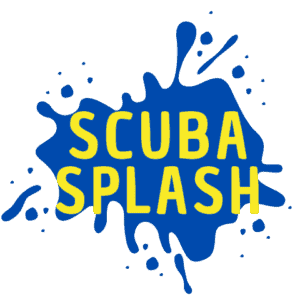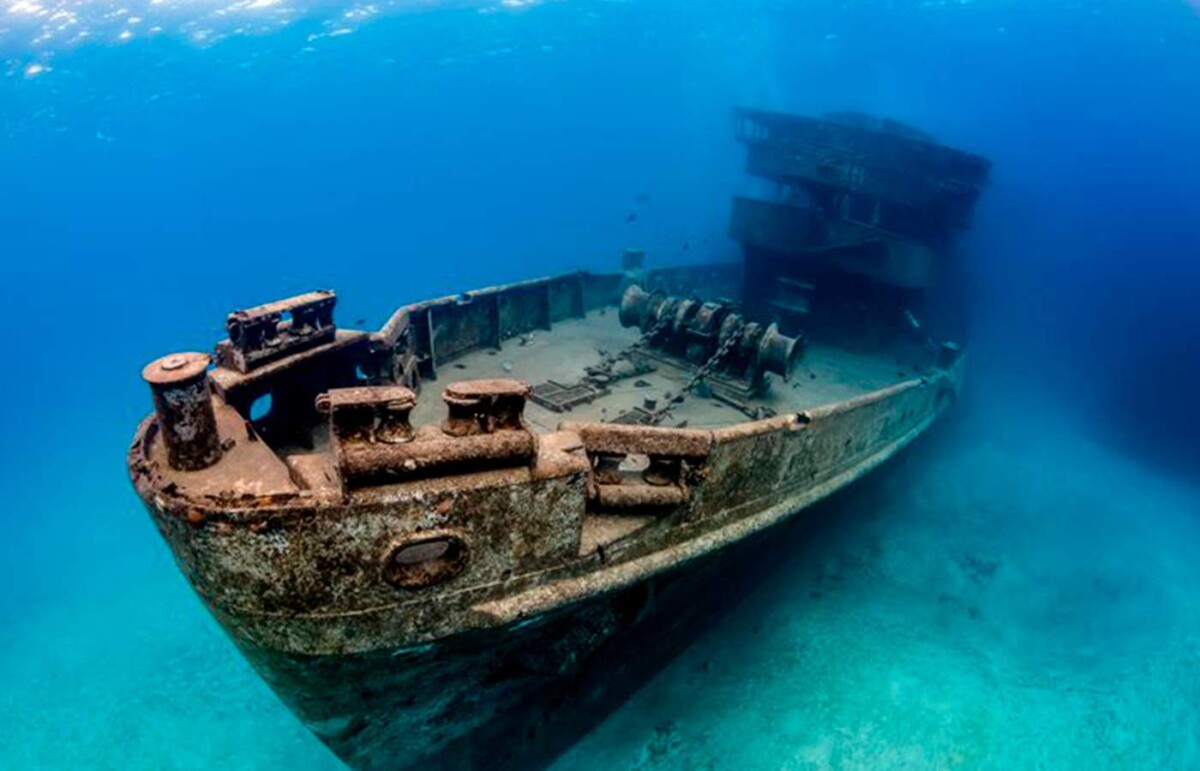Cancun is known as a party city with lots of mixed drinks and late nights. This means that it tends to get overlooked within the diving community especially when it comes to shipwrecks. Luckily for you there are plenty of interesting gems to keep any adventurous diver preoccupied.
Cancun began intentionally sinking old ships in 1980 to create artificial reefs and dive sites for tourism. Several ships were successfully sunk up until 2000. Cancun has since gone on to create an entire underwater museum called MUSA.
The ships that Cancun has sunk are mostly from WWII that formally belonged to the US Navy. All of them are in great condition and covered in coral, sea sponges, and tons of marine life.
Cancun Diving Conditions
| Diving: Year-round | Fewer Crowds: May-November |
| Water Temp: 79-84° F (26-29° C) | Visibility: 66-148 Ft (20-45° m) |
| Air Temp: 84-97° F (29-36 C) | Wetsuit: 3-5 mm shorty |
Chairel
Expect to See: Barracuda, snapper, lionfish, eel, sea cucumber, coral
Skill Level: Intermediate
During the 80s the Chairel was used as a car ferry connecting Cancun with Isla Mujeres. The ship was eventually replaced with a bigger one and the Chairel was converted into a floating restaurant in 1990.
On October 18, 2000 the Chairel was scheduled to be intentionally sunk to create an artificial reef and dive site. However, bad weather rushed in and the ship was sunk in a hurry. The rough waters and quick sinking resulted in the ship landing upside down on the ocean floor.
The ship might be upside down but it turned into a vibrant dive site with lots of marine life including green moray eels, snapper, barracuda and sea cucumbers.
Divers are not permitted to go inside the ship but there are tons of things on the outside to keep anyone occupied.
The current at this site is strong and the depth maxes out at 89 feet (27 m) so for these reasons it’s best to be an intermediate diver.

Juan Escutia C-56
Expect to See: Barracuda, tuna, wrasse, stingray, coral
Skill Level: Beginner-Intermediate
The C-56 is a 184 foot (56 m) WWII US navy gunship. Originally named USS Knave (AM-256) and first set out to sea in 1943 and retired in 1946.
The ship was used as a training school for the US Navy in Little Creek Virginia shortly after serving in WWII. C-56 was later purchased by the Mexican Navy in October 1962 and eventually sunk to create an artificial reef in October 2000.
The ship is fully intact and covered in coral formations. There are many species of fish around the ship including snapper, rays, barracuda, and tuna.
During the winter months, December-March spotted eagle rays migrate through. You can expect to see up to 100 of them on each dive.
Wholes have been cut in the ship to allow plenty of entry and exit points to explore the interior at your leisure. There are two levels on the ship and safety lines to help guide you through.
The C-56 lays 90 feet (27 m) below the surface. The current ranges from relatively mild to strong. It’s only suitable for beginners when the current is mild.
This shipwreck is located just a little south of Cancun in a town called Puerto Morelos. It takes 20 minutes by boat to reach the site from Puerto Morelos.
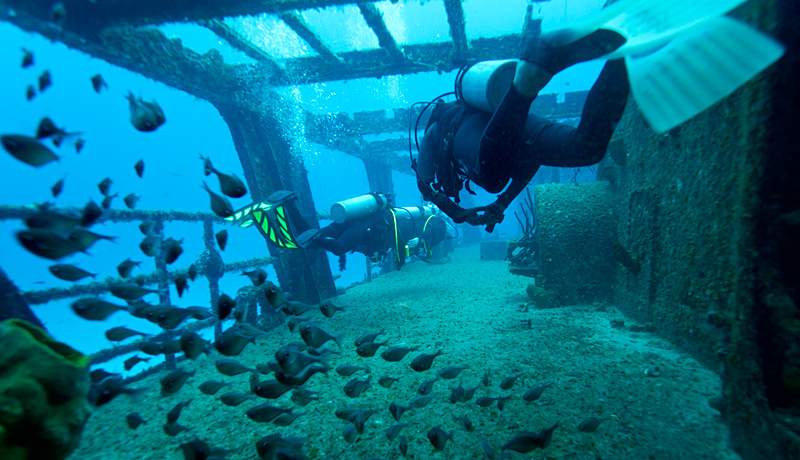
Felipe Xicoténcatl C-53
Expect to See: grouper, eel, shrimp, starfish, tropical fish, coral, sea sponges
Skill Level: Intermediate
This ship was formerly a minesweeper during WWII for the US Navy and officially launch in August 1943. It was originally named USS Scuffle and measures 184 feet (56 m) long.
The ship was sold to the Mexican navy in October 1962 and converted into a gunboat. The C-53 was used to patrol the Gulf of Mexico and the Caribbean Sea. It was later intentionally sunk on June 5 2000 off the coast of Cozumel near Chankanaab Park.
In 2005 Hurricane Wilma moved the sunken ship 100 feet (30 m) north of it’s original position and nearly ripped the ship in half. Though there was some damage done, the ship is in good condition and is safe to penetrate.
The C-53 lays at a depth of 85 feet (26 m) which makes it open to advanced certified divers. It sits upright on top of a sandbar.
There is a strong current on the way down which subsides once you reach depth. Guidelines are used to help divers in and out of the water.
If you plan on going inside then a flashlight is needed to see through the interior passageways. Also, while exploring the inside of the ship you will need to have buoyancy control and be comfortable moving through overhead spaces and doorways.
El Frio
Expect to See: Dolphins, barracuda, jacks, grouper, turtles, eel, ray, jewfish, coral
Skill Level: Intermediate
The El Frio, also commonly called Ultrafreeze, is located off the coast of Isla Mujeres. The ship caught fire while docked in 1978 and was burned beyond repair. The site gets it’s name from the water temperature becoming noticeably colder as you approach the ship.
In 1979, after the fire, the ship was tugged 7 miles (11km) to be intentionally sunk for the purpose of creating an artificial reef and dive site.
The former cargo ship is 200 feet (61 m) long and lays in the bay between Cancun and Isla Mujeres. El Frio rests on the ocean floor 90 feet (27 m) below the surface.
In 1992, Hurricane Andrew split the ship’s hull on the starboard side exposing the interior. Taking a peak inside you can see lots of cables, some staircases and cargo holds. Divers are allowed to enter the ship and wander through.
Bright green, red, and yellow coral encase the wheel house with schools of barracuda, jacks, and tarpon gather.
There is sometimes a relatively strong current on the way down so keep that in mind if you are a beginner. The boat ride takes about 30-45 minutes departing from either Cancun or Isla Mujeres.
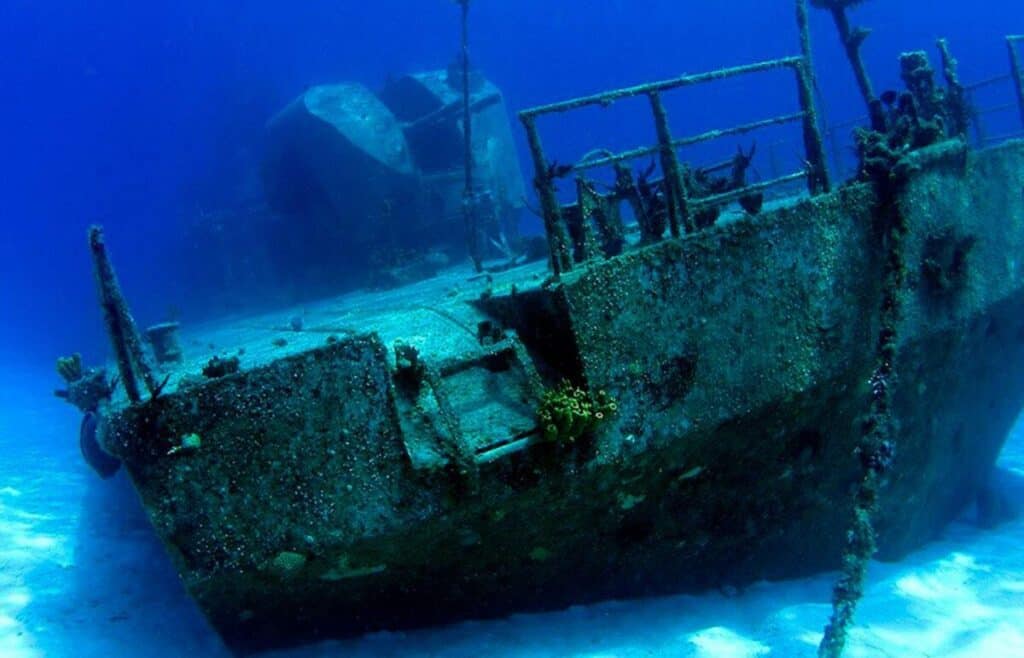
General Anaya C-58
Expect to See: Reef sharks, barracuda, grouper, rays, eel, lionfish, parrotfish, sea horses, starfish, coral
Skill Level: Intermediate
Originally named USS Harlequin, then later called General Anaya, the C-58 was used as a minesweeper in the Atlantic Ocean during WWII. The 184 foot (56 m) long ship was used until May 1946.
In October 1962 C-58 was sold to the Mexican Navy and used as an oceanic research vessel from 1976-1978.
The C-58 was intentionally sunk in the 1980s by the Mexican Navy to create an artificial reef and dive site off the coast of Cancun.
The wreck was split in half in 2005 when Hurricane Wilma wreaked havoc on the area. Luckily though, it turned out to be a good thing. Because of the way the ship split, all the interior rooms are open for exploring.
The ship is very well preserved and a unique shipwreck site as it is split in half and easily accessible. There’s no wonder why C-58 is one of the top 3 shipwreck sites in Cancun.
Large schools of eagle rays migrate here from December though March. During this time tons of rays surround the ship making it an even better site to dive.
The shipwreck sits 80 feet (24 m) below the surface in waters with strong currents. Visibility is 65 feet (20 m). To dive here, it’s best to be at least an intermediate diver.
It takes 30-40 minutes by boat to reach the site from Cancun or Puerto Morelos.
Hondureño
Expect to See: Nurse sharks, cobia, amberjack, grouper, snapper, cobia, parrotfish, stonefish, eel, lobster, coral
Skill Level: Beginner
The Honureno is located just 2 miles (3 km) off the coast of North Beach on Isla Mujeres. This 120 foot (36 m) steel shrimp boat sank in 1988. The ship got caught in Hurricane Gilbert which is one of the strongest hurricanes to hit Isla Mujeres.
There are huge green moray eels here that are 5 feet (1.5 m) long. You will also see schools of cobia fish and rainbow parrotfish. Nurse sharks lurk around the wreck too.
The ship lays 70 feet (21 m) below the surface and visibility is 65 feet (20 m). It only takes 10 minutes by boat to reach the site from Isla Mujeres.
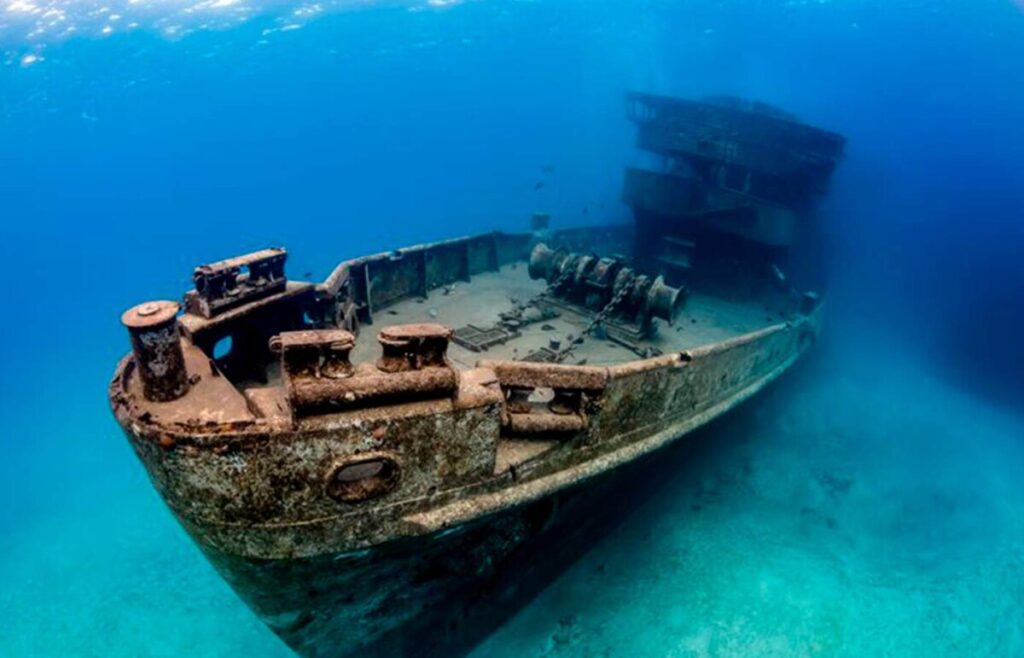
Juan de la Barrera C-55
Expect to See: Barracuda, grouper, snapper, rays, eel, coral
Skill Level: Intermediate to Advanced
The C-55 Mine Sweeper was built in San Francisco, USA, and officially set sail in 1943. The ship has had several names but started off as USS Ransom (AM-283). The ship was used during WWII for patrolling islands along the South Pacific. C-55 was also used as a minesweeper in the East China Sea and around Japan.
C-55 was used on and off until February 1955 when the ship was officially retired. The Mexican Navy purchased the ship in 1962 where it was used until 2000.
In 2000 the C-55 was intentionally sunk off the coast of Cancun to create an artificial reef and dive site.
Unfortunately, in 2005, Hurricane Wilma damaged the sunken ship and broke the hull into 4 sections.
Loggerhead turtles, reef sharks and eagle rays are commonly seen at the site. From December to March spotted eagle rays migrate to the area and it’s normal to see upwards of 100 of them at once.
Currents here are rather strong so it’s recommended that divers at least be at an intermediate skill level. Maximum depth is 82 feet (25 m) and visibility is 40 feet (12 m).
Nearby in Cozumel
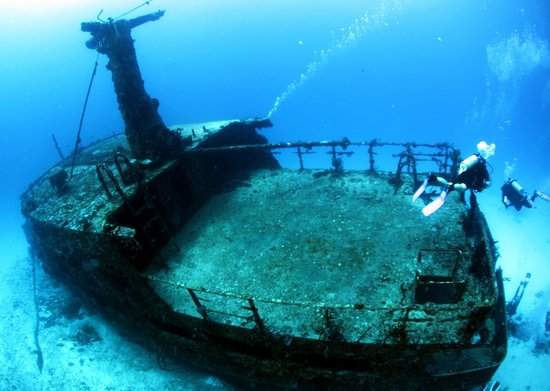
Mama Viña
Expect to See: Bull sharks (winter months), barracuda, turtles, rays, eel, lobster, tropical fish, coral, sea fans
Skill Level: Intermediate
The Mama Viña was a former shrimping boat that was intentionally sunk in 1995. The ship is in good condition and densely coated in soft coral formations.
There is a nice population of garden eels, stingrays, morays, and spotted eagle rays. Lobsters and schools of small silverfish are also found on the wreck.
There are always lots of tropical fish at Mama Viña and Bull sharks are frequently seen during the winter months.
There is a current at the wreck site so it’s usually explored as a drift dive starting at the stern and circling around.
The Mama Viña is located at a depth of 100 feet (30 m) and most dive centers want at least 25 logged dives before they take you to the location.
It’s a 35-minute boat ride from Playa del Carmen, Cozumel to reach the wreck site.
